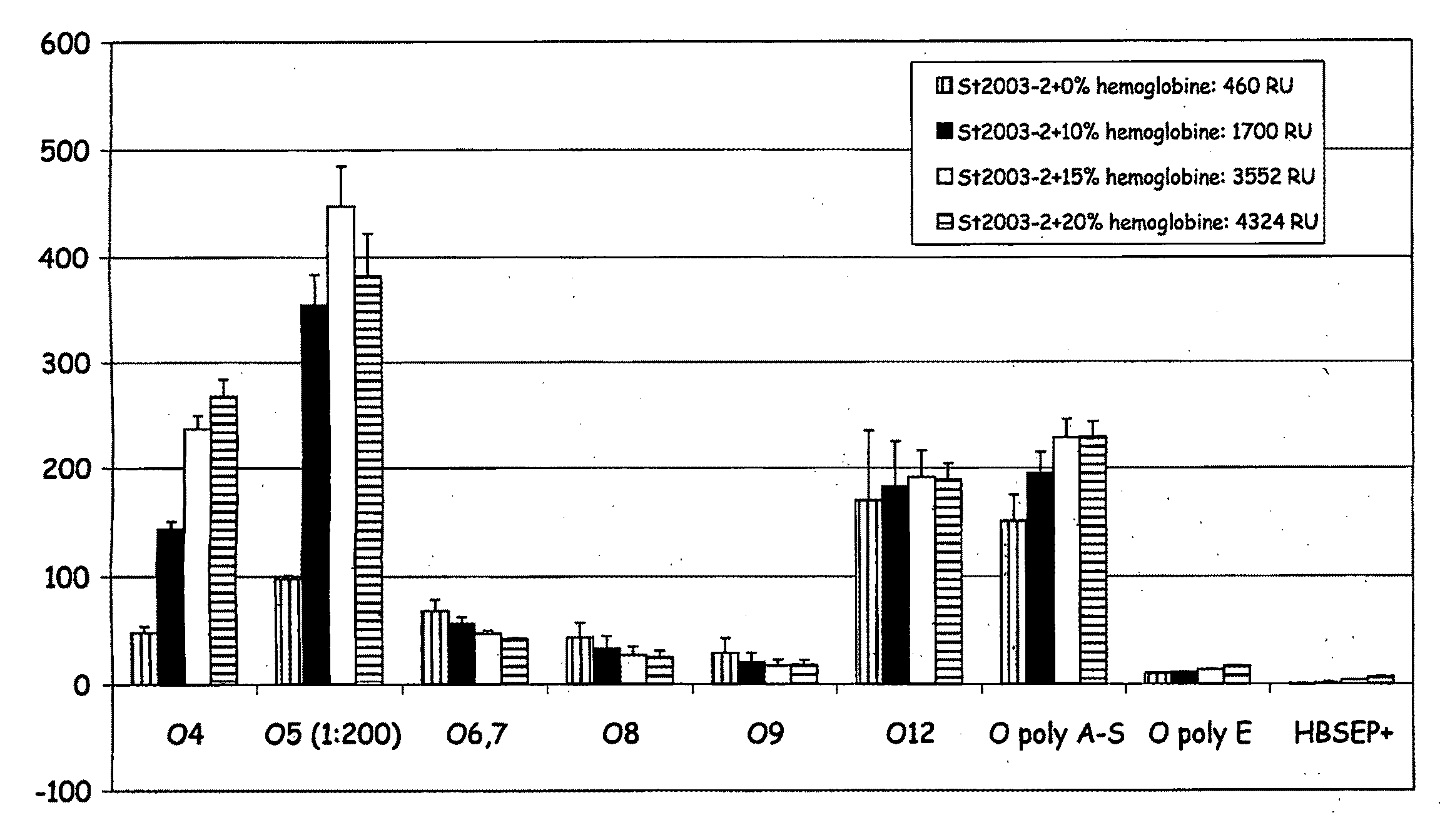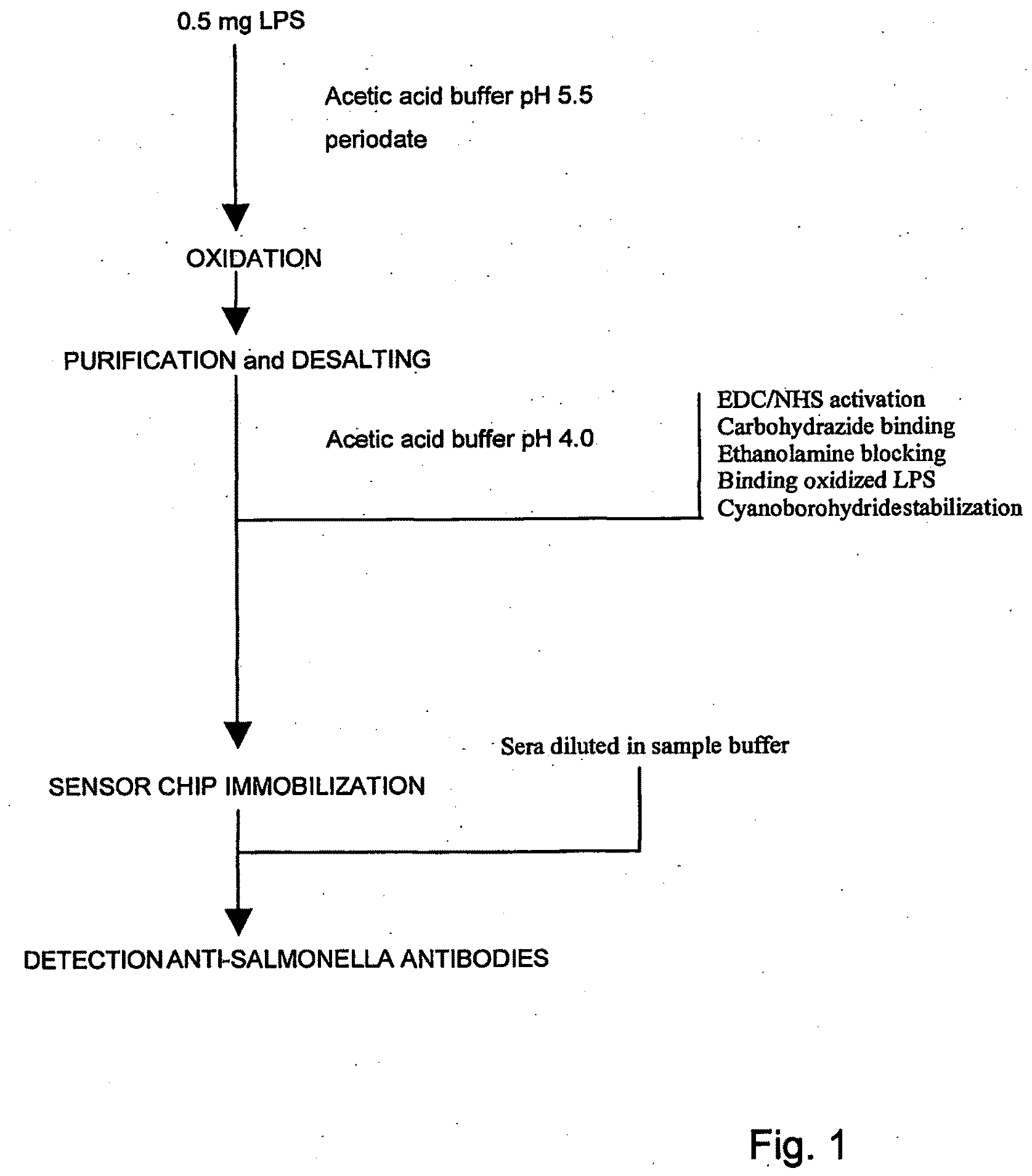Immobilisation of Antigenic Carbohydrates to Support Detection of Pathogenic Microorganisms
a technology of antigenic carbohydrates and pathogenic microorganisms, applied in the field of chemistry and diagnosis, can solve the problems of inability to meet large-scale screening programs, cumbersome approaches, and inability to detect pathogenic microorganisms, and achieve the effect of improving robustness and sensitivity
- Summary
- Abstract
- Description
- Claims
- Application Information
AI Technical Summary
Benefits of technology
Problems solved by technology
Method used
Image
Examples
example 1
1. Materials and Methods
[0125]1.1 Materials
[0126]1.1.1 Chemicals
[0127]Amine-coupling kits, consisting of N-hydroxysuccinimide (NHS), 1-ethyl-3-(3-dimethylaminopropyl)carbodimide hydrochloride (EDC) and ethanolamine hydrochloride—sodium hydroxide pH 8.5 and the running buffer (HBS-EP), containing 10 mM HEPES, 150 mM sodium hydrochloride, 3 mM EDTA and 0.005% (v / v) surfactant P20 at pH 7.4, were bought from Biacore AB (Uppsala, Sweden), which also supplied ready-to-use 10 mM glycine and 50 mM sodium hydroxide. Ethanol, ethylene glycol, sodium chloride, sodium hydroxide and trichloroacetic acid (TCA) were purchased from Merck (Darmstadt, Germany). Carboxymethylated-dextran sodium salt, sodium, cyanoborohydride and carbohydrazide were obtained from Fluka Chemie GmbH (Buchs, Switzerland). CHAPS (Plus one) was delivered by Pharmacia Biotech (Uppsala, Sweden). Sodium acetate trihydrate and acetic acid were supplied by J. T. Baker (Deventer, The Netherlands). Guanidine hydrochloride was obt...
example 5
Determination of Anti-Salmonella Antibodies in Exotic Avian Species Using an SPR Biosensor[AAB10]
1. Introduction
[0290]1.1 Aim of Study
[0291]The aim of this investigation was to explore whether the developed SPR biosensor technology based on the use of immobilized selected Salmonella LPS to indirectly detect Salmonella infections in food-producing animals, is able to detect such infections in exotic animal species as well.
2. Materials
[0292]Plasma from tocotoucans (Rhamphastos toco) and a sharp-tailed grouse (Tympanuchus phasianellus), which were infected with S. typhimurium of different phage-types, were kindly provided by Dr. W. Schaftenaar and Ing. M. de Boer (Veterinary Department, Rotterdam Zoo, The Netherlands). The disease history of these animals is the following.
[0293]From the feces of a Tocotoucan sampled on Mar. 24, 1994, S. typhimurium phagetype 292 was isolated. From another feces sample of the same bird, —S. typhimurium phagetype 352 was isolated on Jun. 28, 1994. On Aug...
example 6
Detection of Bacteriophage Felix O1 (FO1) Through its Binding to Salmonella LPS Immobilized on an SPR Biosensor Chip Surface
1. Goal
[0299]To determine the binding of the bacteriophage FO1 to LPS immobilized to the biosensor surface.
2. Approach
[0300]To prove binding of bacteriophage Felix O1 (FO1, Felix d'Hérelle Reference Centre for Bacterial Viruses, Laval, Canada) to Salmonella LPS, the bacteriophage was diluted in HBSEP to obtain a concentration series. These samples were injected for two minutes on the biosensor to allow binding to LPS from S. typhimurium, S. enteritidis, S. goldcoast and S. livingstone, which were each immobilized separately on an individual flow channel of the sensor chip.
3. Results
[0301]The results are summarized in FIG. 11.
[0302]Although a relatively high concentration of bacteriophage was needed to obtain a significant response, it is evident from this experiment that 109 PFU of FO1 bacteriophages / mL and higher bound to LPS coupled to the chip surface.
PUM
| Property | Measurement | Unit |
|---|---|---|
| Volume | aaaaa | aaaaa |
| Volume | aaaaa | aaaaa |
| Volume | aaaaa | aaaaa |
Abstract
Description
Claims
Application Information
 Login to view more
Login to view more - R&D Engineer
- R&D Manager
- IP Professional
- Industry Leading Data Capabilities
- Powerful AI technology
- Patent DNA Extraction
Browse by: Latest US Patents, China's latest patents, Technical Efficacy Thesaurus, Application Domain, Technology Topic.
© 2024 PatSnap. All rights reserved.Legal|Privacy policy|Modern Slavery Act Transparency Statement|Sitemap



